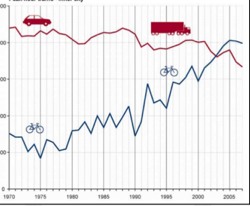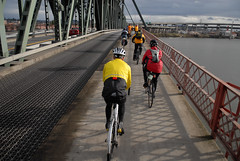The City of Portland Bureau of Transportation has released a full report and analysis on their 2009 bike counts. Last month, an unauthorized and incomplete version of the report leaked to the Willamette Week revealed that bike ridership in Portland had taken its first dip since 1995.
Many theories cropped up to account for this dip and PBOT’s just-released report (which was also partially leaked to the Willamette Week yesterday) explains what they feel are three key factors leading to the decline.
But first, here are some 2009 numbers presented in the report (PDF here):
- Bike traffic on Portland’s four main bridges (Broadway, Hawthorne, Burnside, Steel) and at 101 count locations showed a one-year decrease of 6 and 5% respectively.
- On the Hawthorne Bridge, bikes make up 21% of all traffic, up one percent from 2008.
- Trips by car and transit were also down and the overall percentage of bike traffic on the four bridges remained constant at 13%.
- Overall, bike traffic has gone up 180% since the 2000/2001 counts.
- Helmet use and the number of female riders also decreased slightly in the last year.
Although the message from PBOT is that this slight dip in bike traffic isn’t a big deal, they still decided to present analysis in their report as to why it happened. According to them, three main factors account for the decrease; the down economy, people returning to their cars after trying bikes during 2008’s gas price spike, and the low-hanging fruit phenomenon.
PBOT says auto traffic counts in 26 locations around the city show a 7% decrease in 2009. PBOT also cites Oregon Department of Transportation data that shows a 5% decrease in northbound travel on I-5 and an 8% decrease in the southbound direction between the Oregon-Washington border and Wilsonville. TriMet’s average weekday boardings are also down 7% from one year ago.
The pool of people willing to use a bicycle for transportation is almost exhausted given the appeal of the city’s current bicycle transportation infrastructure.”
– From an analysis by PBOT on why they counted fewer bike riders in 2009
In their report, PBOT says that the 2008 gas price spike likely had a lot to do with the 30% growth in bike use between 2007 and 2008. To explain why fewer people used bicycles in 2009, PBOT feels “it is reasonable to expect that some who rode in 2008 may have returned to driving.”
Perhaps the most interesting reason PBOT gives for the 2009 biking decrease (and something Geller already mentioned in the original Willamette Week article) is that Portland’s existing bike network appeals only to a limited number of people, most of whom are already riding. Geller has said on several past occasions that he feels Portland’s bike infrastructure is not keeping up with ridership. On a similar note, here’s how the PBOT report explains it (emphasis mine):
“While Portland has seen rapid growth in bicycle ridership in the past decade, without the development of world-class bicycle facilities this growth will logically end at some point… the pool of people willing to use a bicycle for transportation is almost exhausted given the appeal of the city’s current bicycle transportation infrastructure.”

use in Copenhagen to illustrate
that a dip in ridership is no big deal.
Regardless of why the numbers are down this year, PBOT says it’s nothing to get too worked up about. In the conclusion of their report they share a graph of bike use from Copenhagen that shows several dips — the point being that the overall trend is what’s important, not a one-time dip.
As for why it’s taken so long for this report to come out (it’s usually released in November, and the Willamette Week’s reporting speculates that PBOT wanted to hold back this news until after their 2030 Bike Plan was adopted by City Council), Geller maintains that they have simply not had time to devote to it. He told me today that, “It wouldn’t even be coming out now if it weren’t for the fact that it leaked out.”
Download the full 2009 bike count report and analysis here (750kb PDF).


